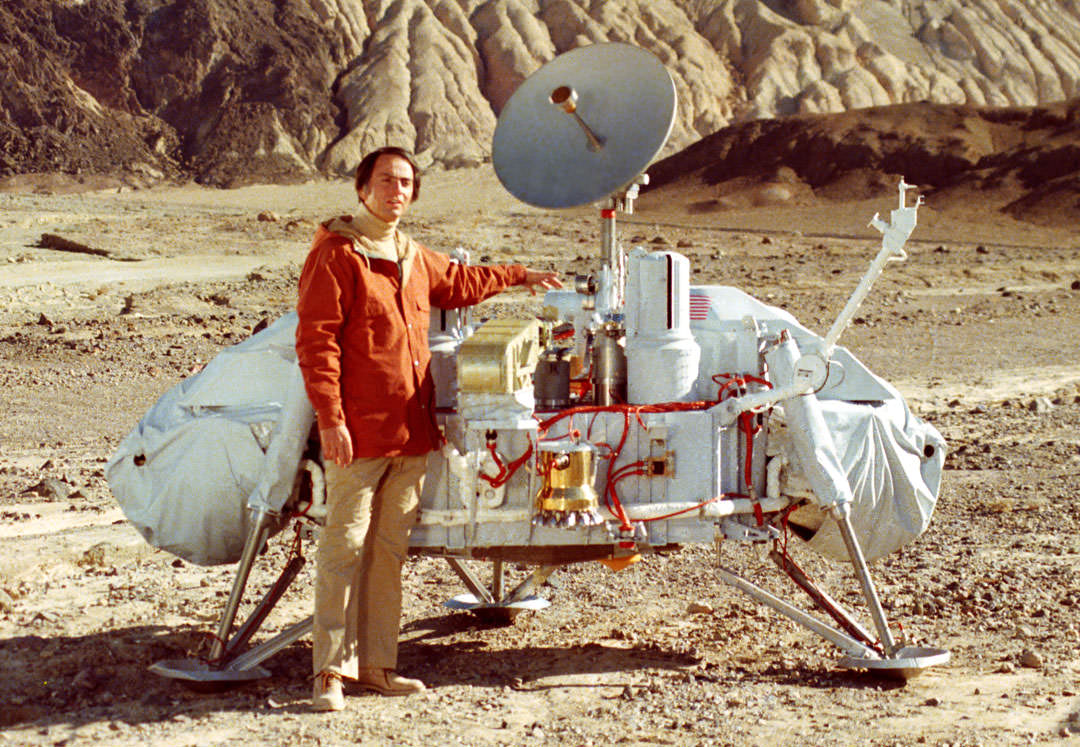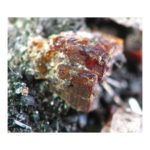Featured image: The late Carl Sagan stands next to a model of the Viking lander. Credit: NASA
By Carol Cleland (University of Colorado Boulder)
Cite as: Cleland, C. (2021) “Why searching for extraterrestrial life with a universal biosignature detection framework is a mistake.” Primordial Scoop, 2021, e1122. https://doi.org/10.52400/OAFE7594
A couple of weeks ago a group affiliated with NASA released a “white paper” claiming that scientists need a universal biosignature detection framework for searching for extraterrestrial life. After championing the need for such a framework, the white paper spends the next 60 pages sketching a preliminary proposal for such a framework and asks the astrobiology community to weigh in with suggestions for improving it.
Unfortunately, there is a serious problem with the first part of their proposal: Any “universal” framework for detecting biosignatures will be based on the only form of life with which we are acquainted, namely, familiar Earth life, which descends from a last universal common ancestor. The ways in which the single example of life with which we are familiar is representative and unrepresentative of life are unknown until we have more examples of life with which to compare it. Some of the features that are universal to familiar life may be the product of chemical and physical contingencies present during the origin and early evolution of life on Earth.
Somewhat ironically, the cases the authors use to illustrate the putative fruitfulness of a universal biosignature detection framework underscore this problem. Consider their discussion of the results of the Viking mission’s LR (Label Release) experiment. They argue that a universal framework would have had the virtue of having “more clearly indicated that … an abiotic interpretation had not yet been ruled out” (p. 5).
But at the time this wasn’t the problem: NASA accepted an abiotic interpretation of the results of the LR experiment and ruled out a biotic interpretation.
Moreover, as Benner points out (in an earlier blog), they accepted the abiotic interpretation based on the results of the crude Viking GC-MS, which were themselves misleading (Martian soil contains organic molecules) and subsequently spent the next 40+ years hunting for a plausible inorganic oxidant, from hydrogen peroxide to exotic states of iron to perchlorate, the official (but very problematic) current explanation for the results of the LR experiment.
The problem with the interpretation of the LR experiment was not a lack of attention to the possibility of an abiotic interpretation, but a lack of attention to a biotic interpretation. What should have been concluded from the Viking LR experiment was that the results were truly ambiguous for life.
The authors of the white paper say (p. 3) that their aim is to formulate a universal biosignature detection framework that avoids false positives and false negatives, but this is exactly what a universal framework based on a single, possibly unrepresentative, example of life can’t do. Unfamiliar forms of life will challenge our current concept of life in ways that can’t be anticipated in advance for the simple reason that we don’t know which characteristics of familiar life are truly universal to all life.
The danger of the approach being advocated in the white paper is that, in a misguided effort to avoid false positives, it will classify promising cases of a truly novel form of life as nonliving period. Instead of worrying about avoiding false positives and false negatives NASA would be better off coming up with a strategy for identifying cases that straddle the boundaries of our current concepts of living and nonliving processes for purposes of further scientific investigation. Such cases will resist being dismissed as false positives and false negatives. Puzzling natural phenomena of this sort are the types of cases that hold forth the greatest promise for leading us to a more general universal understanding of life. In sum, what is needed is the opposite of what they are proposing, namely, a framework for searching for extraterrestrial life that identifies cases that are anomalous in biologically promising ways—cases that resemble familiar life in seemingly telling ways but also differ from it in unanticipated ways—for purposes of more in depth astrobiological investigation.




But how do you propose to actually SEARCH for (or FIND, or RECOGNIZE) these ambiguous (i.e. interesting) candidates? Don’t you still need some sort of “universal biosignature framework” for it, or at least a set of specific frameworks?
Not really. To find evolving replicators in concentrated sulfuric acid in the clouds of Venus, you would need completely different searching methods and hypotheses than when you look for life deep in Europa oceans.
… that’s what I meant with “set of specific frameworks” (maybe “set of specific biosignatures” or “group of specific biosignatures” would have been better), i.e. a specific biosignature for each particular environment. My point was, you still need some sort of pre-defined (set of) biosignature(s) in order to “identifies cases that are anomalous in biologically promising ways […] for purposes of more in depth astrobiological investigation”.
Sure, as long as you keep updating the “set of specific frameworks” every time anyone finds something unexpected. In other words, you cannot make a framework before you know the life forms you are looking for. The only framework you can make is for the life we know. You cannot make a framework for life we do not know (a.k.a. alien life).
A good article by Carol and good points and comments by Daniel and Jan. Based upon our current knowledge, it seems logical that, in an aqueous environment such as Europa, Ganymede, Enceladus, Mars and (perhaps) a more ambient Venus, all life forms will use a polysugar-phosphate (a polyelectrolyte) backbone in their information storage molecules. However, the nature of the sugars and the heterocyclic bases may vary, as the results from the Benner, Eschenmoser, Herdewijn and Holliger labs have shown, during these past 35 years. Steven Benner has already described in detail a device that is able to detect and quantify any putative alien polyelectrolytes obtained by future sampling missions (Astrobiology 2017, 17(9), 840-851, http://doi.org/10.1089/ast.2016.1611).
If, however, life can arise in a non-aqueous environment, like the low temperature hydrocarbon lakes and seas on Titan, then logic would suggest that its essential framework biopolymers will be very different to those found in terran life, as it is well established that terran proteins, nucleic acids and polysaccharides are highly insoluble in hydrocarbon and other non-polar solvents, particularly at the very low temperatures encountered there. Armed with a knowledge of the organic inventory present in Titan’s atmosphere, we chemists can make predictions as to how these molecules will react with each other and what the products will be, including any polymers that could act as information storage systems in hypothetical Titans. We can then go into the lab and design experiments in order to test these predictions. Benner et al have proposed polyethers, (which could arise from the hydration and polymerisation of acetylene and other alkynes known to be present on Titan) as potential information storage molecules for possible Titan life forms. These molecules will have a repeating -CHR-O- unit, with the two lone pairs of electrons on the regularly spaced oxygen atoms acting (in the cold hydrocarbon environs) rather like the negatively charged oxygen atoms in the nucleic acids of terran organisms, and preventing kinking and folding via Coulombic interactions. Detecting them, however, will require a very different form of analyser to that used for polyelectrolytes.